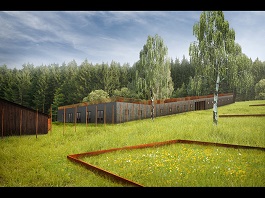
A memorial to the Romani Holocaust is being created in Blanensko
 |
The construction work lasted about five years, and now the creation of the exhibition is to begin, which will take a year. "If no problems arise, everything will be finished in August next year," Pánková stated.
She mentioned that 20 million was spent on purchasing the site from a private owner, 78 million on reconstruction and construction of the buildings, and on creating the exhibition. "Out of the seven prison facilities, only one has been preserved, which we renovated, as well as the partially preserved guardhouse. We also built a new information center," Pánková said.
There will be an exhibition in all three buildings, aiming to highlight the history of the site. Initially, it was a collection camp for Moravian Roma, who were transported from Hodonín to the Auschwitz concentration camp; then it housed expelled Germans, some of whom also perished, and during the Communist regime, political prisoners. "We also tried to restore the terrain to its original state. We fenced off the memorial site and erected a pole for each deceased person who died there. There are 288 poles for 207 Roma and others were the expelled Germans," added Pánková.
According to her, the deceased Roma are buried in a nearby grove. "It's a little cemetery called Žalkov. There are crosses, and it is enclosed by a fence. The site has been declared a cultural monument," Pánková said.
The exhibition will feature Czech-English texts, photographs, artifacts, and also short films with witnesses that will portray the lives of both prisoners and guards. "For example, there will be a list of the deceased, a timeline that shows what was happening in the Czech lands, in Europe, and in the camp, but there will also be phone booths that allow listening to recordings of some of the witnesses," Pánková added. The exhibition will serve schools and the public.
According to Pánková, it is important to create memorials. "It is crucial in today's time, when people are being killed and imprisoned, to prevent such occurrences from repeating as they did in the past."
The English translation is powered by AI tool. Switch to Czech to view the original text source.
0 comments
add comment
Related articles
0
08.12.2017 | The conversion of the memorial in Hodonín near Kunštát to a Roma museum has begun
0
29.06.2017 | The Hodonín u Kunštátu Memorial will not open now, preparations have stopped
0
18.02.2017 | The Hodonín u Kunštátu Memorial could be under the Romani Culture Museum
0
04.01.2017 | The Hodonín u Kunštátu Memorial is set to open in the summer
0
11.08.2016 | From the former Schindler's factory, a Holocaust memorial should be established
0
19.08.2012 | The memorial to the Romani Holocaust will open in Blansko in 2016






